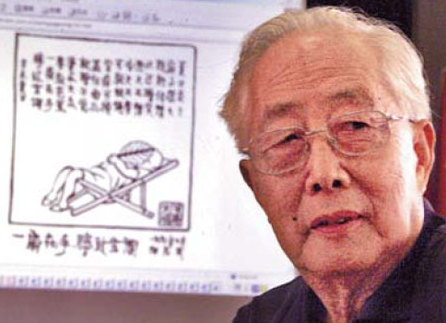Hua Junwu, one of China's most renowned news cartoonists, died on Sunday in Beijing. He was 95.

This picture taken in July 2001 shows Hua Junwu in front of one of his works during the launch of a cartoon website. [China Daily]
His caricatures typically featured people with unkempt dress and messy hair, unadorned yet imposing; and despite the lack of detail, Hua vividly captured their inner state, critics say.
"Hua will be remembered as the pioneer of political caricature in modern China, " said Zhang Yaoning, vice-president and secretary general of the China Journalism Caricature Research Society.
Born in Hangzhou, Zhejiang province, in 1915, Hua started to draw cartoons in 1930 for the campus journal when he was a middle school student. His first cartoon work depicted students with exaggerated painful expressions while being vaccinated.
But three years later, Hua was expelled from No 1 Zhejiang Provincial Middle School when he raised a protest against a teacher who treated his classmates unfairly.
Hua then left for Shanghai and at the middle school attached to Shanghai Tatong University, was punished twice for his defiant attitude toward, and cartoons of, a bullying teacher.
In 1936, he began work as a bank clerk. His stay in Shanghai turned out to be the first important phase in his artistic career. There, Hua started to draw political caricatures, using his characteristic technique of portraying sketchy but vivid crowds.
When the War of Resistance against Japanese Aggression broke out in 1937 and Shanghai was occupied, Hua quit his job and went to Yan'an, Shaanxi province, the revolutionary base of the Communist Party of China.
From the early 1940s, Hua gradually established himself as a popular political caricaturist with his unique style of Chinese ink brush on rice paper, and often accompanied by a rhymed verse.
Hua's caricatures were pungent and humorous, a style his son Hua Fangfang attributed to "his optimistic, rebellious and somewhat stubborn, character".
Some of his works in Yan'an targeted the bureaucracy, attracting the attention of Chairman Mao Zedong, who invited him to discuss how to "direct the caricature works at the right targets," as Hua later recalled.
However, his most well-known work during this time was a cartoon image of Chiang Kai-shek, who was so furious that he put Hua on the Kuomintang's most wanted list.
In late 1949, Hua began working for the People's Daily as the director for the arts and culture section, where he conceived New China's first news cartoon column, entitled Satire and Humor.
Hua suffered for his candid creations during the "cultural revolution" (1966-76) and was forced to stop drawing caricatures during the period.
In 1979, Hua was elected vice-chairman of the Chinese Artists Association and played a key role in bringing diversity into artistic creation in the new era.
Hua turned to mainly caricatures on social, rather than political, issues since then.
"Hua was an artist of penetrating insight and acute observation. His works always focus on the very basic, human behavior, something a true caricaturist must always focus on," said art critic Zhong Chengxiang.
"There are few caricaturists today who are as accurate and precise as he was."
|


